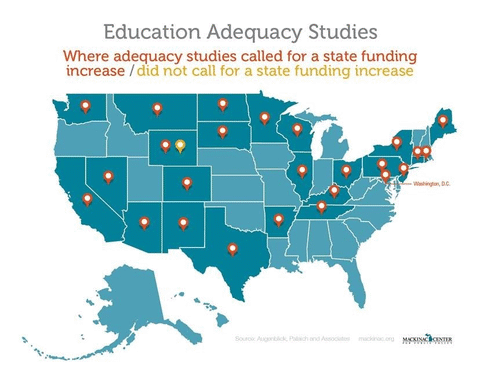Commentary
History Shows Delayed Adequacy Study Will Call for More Money
Michigan already spends more per pupil than the national average
Those anticipating the release of Michigan’s education adequacy study learned this week that, once again, they will have to wait a little longer. While the precise detailed findings are unknown, the embargoed report’s general conclusions should not remain a matter of mystery.
Last September the state granted Colorado-based Augenblick Palaich & Associates a $399,000 contract to determine how much money Michigan needs to spend in order to provide “adequate” services to students. Our state currently ranks 21st in per-pupil spending but 43rd in math and reading achievement on the nation’s report card. Michigan has been spending more than the national average for decades.
The state law that authorized the study called for its completion by March 31. At the eleventh hour, the state agency acknowledged that the process had been held up by problems in data transmission. The deadline was moved back to May 13.
Though APA turned in the study on time, at least according to the granted extension, MIRS News now reports that state bureaucrats were not satisfied with the results. Saying the study did not meet “statutory requirements,” officials levied a fine on the contracted research firm with a new required completion date of June 24.
APA’s findings may not reach the public eye for a while, but interested observers should not be in suspense about one main fact: the study will almost certainly call on Michigan taxpayers to spend more money on schools. The last 13 adequacy studies conducted by APA all reached that same conclusion.
Between 2003 and 2014, various firms, including APA, conducted a total of 39 adequacy studies in 25 different states. Only one, a study performed in high-spending Wyoming, failed to call for additional funds.

Among its more notable projects, APA determined that low-performing Washington, D.C. —which already received about $29,000 per student — should increase funding by 22 percent. Another APA study called for boosting Connecticut’s education expenditures by 35 percent, or $2 billion, even though the state was already one of the nation’s top five in per-pupil spending.
Earlier this year, the Mackinac Center tested the primary assumption behind the forthcoming Michigan adequacy study, namely that more funds all by themselves will improve student achievement. The multi-year, building-level regression analysis found no statistical relationship between spending and results for 27 of 28 different test scores and other academic indicators. The sole exception estimated that a 10 percent spending increase would improve seventh grade math scores by a minuscule fraction of a point.
Accepting that an increase in the state’s K-12 budget will reap rewards in student learning requires a leap of faith. But however long we must wait, an expectation that the state’s adequacy study will call for more money is firmly rooted in evidence from the recent past.
|

History Shows Delayed Adequacy Study Will Call for More Money
Michigan already spends more per pupil than the national average
Those anticipating the release of Michigan’s education adequacy study learned this week that, once again, they will have to wait a little longer. While the precise detailed findings are unknown, the embargoed report’s general conclusions should not remain a matter of mystery.
Last September the state granted Colorado-based Augenblick Palaich & Associates a $399,000 contract to determine how much money Michigan needs to spend in order to provide “adequate” services to students. Our state currently ranks 21st in per-pupil spending but 43rd in math and reading achievement on the nation’s report card. Michigan has been spending more than the national average for decades.
The state law that authorized the study called for its completion by March 31. At the eleventh hour, the state agency acknowledged that the process had been held up by problems in data transmission. The deadline was moved back to May 13.
Though APA turned in the study on time, at least according to the granted extension, MIRS News now reports that state bureaucrats were not satisfied with the results. Saying the study did not meet “statutory requirements,” officials levied a fine on the contracted research firm with a new required completion date of June 24.
APA’s findings may not reach the public eye for a while, but interested observers should not be in suspense about one main fact: the study will almost certainly call on Michigan taxpayers to spend more money on schools. The last 13 adequacy studies conducted by APA all reached that same conclusion.
Between 2003 and 2014, various firms, including APA, conducted a total of 39 adequacy studies in 25 different states. Only one, a study performed in high-spending Wyoming, failed to call for additional funds.
Among its more notable projects, APA determined that low-performing Washington, D.C. —which already received about $29,000 per student — should increase funding by 22 percent. Another APA study called for boosting Connecticut’s education expenditures by 35 percent, or $2 billion, even though the state was already one of the nation’s top five in per-pupil spending.
Earlier this year, the Mackinac Center tested the primary assumption behind the forthcoming Michigan adequacy study, namely that more funds all by themselves will improve student achievement. The multi-year, building-level regression analysis found no statistical relationship between spending and results for 27 of 28 different test scores and other academic indicators. The sole exception estimated that a 10 percent spending increase would improve seventh grade math scores by a minuscule fraction of a point.
Accepting that an increase in the state’s K-12 budget will reap rewards in student learning requires a leap of faith. But however long we must wait, an expectation that the state’s adequacy study will call for more money is firmly rooted in evidence from the recent past.
Michigan Capitol Confidential is the news source produced by the Mackinac Center for Public Policy. Michigan Capitol Confidential reports with a free-market news perspective.